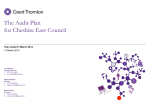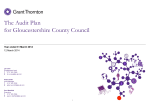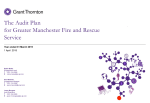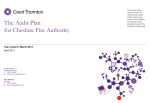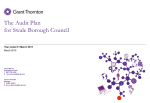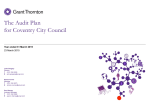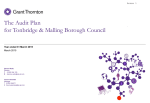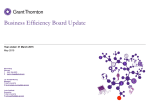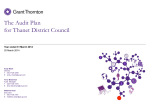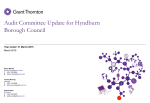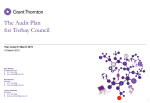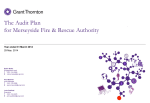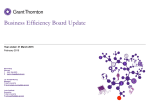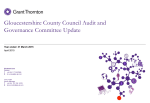Download The Audit Plan – template user guide
Transcript
The Audit Plan for Hertsmere Borough Council Year ended 31 March 2014 March 2014 Phil Westerman Engagement Lead T 020 7728 2548 E [email protected] Trevor Greenlee Manager T 01293 554071 E [email protected] © 2014 Grant Thornton UK LLP | The contents of this report relate only to the matters which have come to our attention, which we believe need to be reported to you as part of our audit process. It is not a comprehensive record of all the relevant matters, which may be subject to change, and in particular we cannot be held responsible to you for reporting all of the risks which may affect the Council or any weaknesses in your internal controls. This report has been prepared solely for your benefit and should not be quoted in whole or in part without our prior written consent. We do not accept any responsibility for any loss occasioned to any third party acting, or refraining from acting on the basis of the content of this report, as this report was not prepared for, nor intended for, any other purpose. Contents Section 1. Understanding your business 2. Developments relevant to your business and the audit 3. Our audit approach 4. Significant risks identified 5. Other risks 6. Results of interim work 7. Value for Money 8. Logistics and our team 9. Fees and independence 10. Communication of audit matters with those charged with governance Appendices A. Action plan © 2014 Grant Thornton UK LLP | Understanding your business In planning our audit we need to understand the challenges and opportunities the Council is facing. We set out a summary of our understanding below. Challenges/opportunities 1. Reduction in funding and financial position 2. • Since the Chancellor's Autumn statement in 2010 central government funding to local authorities has been reducing year on year. This financial environment continues to pose significant challenges for the Council • Delivering efficient and effective services 3. Local government finance reforms 4. • The Local Government Finance Act 2012 introduced changes to the framework for council tax support and business rates with effect from 1 April 2013. The Council has been required to put in place new arrangements locally to implement these changes. • In recent years the Council 's budget process has been supported by efficiency savings from change management and organisational review. The Council's medium term financial strategy anticipates that further efficiency savings will be needed tin future years. Financial statements The Department for Communities and Local Government (DCLG) is proposing to bring forward the timetable for closure of accounts by up to two months, with any change potentially happening as early as 2015/16. Any significant acceleration of the timetable for accounts submission would require the Council to review its processes for accounts preparation. Our response We will We will We will Although not an issue for 2013/14 we will • • • consider the new arrangements for council tax support and business rates and review how the impact of the reforms has been incorporated into the Council's medium term financial plans. • • consider accounting issues associated with the reforms and review the Council's treatment against the 2013/14 Accounting Code of Practice. review the Council's approach to strategic financial planning, financial governance and financial control as part of the work to support our value for money conclusion. © 2014 Grant Thornton UK LLP | monitor developments through our review of Council papers and meetings with senior management. Our value for money conclusion work will consider if the Council continues to have efficient and effective arrangements for the delivery of services. work with the Council to help identify ways of streamlining the accounts preparation process if any acceleration of the accounts timetable is confirmed. Developments relevant to your business and the audit In planning our audit we also consider the impact of key developments in the sector and take account of national audit requirements as set out in the Code of Audit Practice ('the code') and associated guidance. Developments and other requirements 1.Financial reporting 2. Legislation 3. Corporate governance 4. Pensions 5. Financial Pressures 6. Other requirements Changes to the CIPFA Code of Practice, including clarification of Code requirements around PPE valuations and changes to accounting for business rates. Local Government Finance settlement Annual Governance Statement (AGS) Managing service provision with less resource Welfare reform Act 2012 Explanatory foreword The impact of changes to the Local Government pension Scheme (LGPS) The Council is required to submit a Whole of Government accounts pack on which we provide an audit opinion Progress against savings plans The Council completes grant claims and returns on which audit certification is required Our response We will We will We will We will We will We will liaise with the Council's finance team on relevant issues prior to the accounts being prepared discuss the impact of legislative changes with the Council through our regular meetings with senior management and those charged with governance, providing a view where appropriate review the arrangements the Council has in place for the production of the AGS discuss with management the Council's preparations for the changes to the LGPS from 1 April 2014 review the Council's performance against the 2013/14 budget, including delivery against savings plans carry out work on the WGA pack in accordance with requirements ensure that the Council complies with the requirements of the CIPFA Code of Practice through our work to review the 2013/14 financial statements © 2014 Grant Thornton UK LLP | review the AGS and the explanatory foreword to consider whether they are consistent with our knowledge undertake a wider review of financial resilience issues to support our VFM conclusion certify grant claims and returns in accordance with Audit Commission requirements Our audit approach Ensures compliance with International Standards on Auditing (ISAs) Global audit technology Understanding the environment and the entity Understanding the business Inherent risks Significant risks Understanding management’s focus Other risks Evaluating the year’s results Material balances Develop audit plan to obtain reasonable assurance that the Financial Statements as a whole are free from material misstatement and prepared in all materiala respects with the CIPFA Code of Practice framework using our global methodology and audit software Devise audit strategy (planned control reliance?) Yes Extract your data Test controls Test of detail IDEA Substantive Substantive Analyse data analytical analytical Report output using relevant review review to teams parameters Tests of detail General audit procedures Note: a. An item would be considered material to the financial statements if, through its omission or nondisclosure, the financial statements would no longer show a true and fair view. Financial statements Conclude and report Creates and tailors audit programs © 2014 Grant Thornton UK LLP | No Stores audit evidence Documents processes and controls Significant risks identified 'Significant risks often relate to significant non-routine transactions and judgmental matters. Non-routine transactions are transactions that are unusual, either due to size or nature, and that therefore occur infrequently. Judgmental matters may include the development of accounting estimates for which there is significant measurement uncertainty' (ISA 315). In this section we outline the significant risks of material misstatement which we have identified. There are two presumed significant risks which are applicable to all audits under auditing standards (International Standards on Auditing – ISAs) which are listed below: Significant risk Description Substantive audit procedures The revenue cycle includes fraudulent transactions Under ISA 240 there is a presumed risk that revenue may be misstated due to the improper recognition of revenue. Work planned: Under ISA 240 there is a presumed risk that the risk of management over-ride of controls is present in all entities. Work completed to date: Management over-ride of controls © 2014 Grant Thornton UK LLP | Review and testing of revenue recognition policies Testing of material revenue streams Testing of journal entries to 31 January 2014 Further work planned: Review of accounting estimates, judgments and decisions made by management Testing of journal entries for the remainder of the year Review of unusual significant transactions Other risks identified The auditor should evaluate the design and determine the implementation of the entity's controls, including relevant control activities, over those risks for which, in the auditor's judgment, it is not possible or practicable to reduce the risks of material misstatement at the assertion level to an acceptably low level with audit evidence obtained only from substantive procedures (ISA 315). In this section we outline the other risks of material misstatement which we have identified as a result of our planning. Other reasonably possible risks Description Work completed to date Further work planned Operating expenses Creditors understated or not recorded in the correct period Substantive testing of creditor balances Cut-off testing to ensure that transactions have been recorded in the correct accounting period. Employee remuneration Employee remuneration accrual understated Identification and walkthrough of system controls Substantive testing of payroll expenses Welfare Expenditure Welfare benefit expenditure improperly computed Identification and walkthrough of system controls Substantive testing of a sample of benefit claims Review reconciliation of benefit expenditure to the benefit subsidy claim Complete benefit software diagnostic tool, uprating checks and analytical review compared to prior year subsidy claim Identification and walkthrough of system controls Evaluate the qualifications and work of the valuation expert Substantively test revaluations to supporting documentation Review supporting documentation to confirm overall carrying value per accounts does not differ materially from fair value. Property, Plant & Equipment Revaluation measurement not correct © 2014 Grant Thornton UK LLP | Identification and walkthrough of system controls Results of interim audit work The findings of our interim audit work, and the impact of our findings on the accounts audit approach, are summarised in the table below: Internal audit Work performed and findings Conclusion We have reviewed internal audit's overall arrangements in accordance with auditing standards. Our work has not identified any issues which we wish to bring to your attention. Overall we have concluded that the internal audit service continues to provide an independent and satisfactory service to the Council and that internal audit work contributes to an effective internal control environment at the Council. We also reviewed internal audit's work on the Council's key financial systems to date. We have not identified any significant weaknesses impacting on our responsibilities. Walkthrough testing We perform walkthrough tests of controls operating in areas where we consider that there is a risk of material misstatement to the financial statements. Our review of internal audit work to date has not identified any weaknesses which impact on our audit approach. Our work has not identified any weaknesses which impact on our audit approach. Our walkthrough testing is substantially complete. Our work has not identified any issues which we wish to bring to your attention. Internal controls have been implemented in accordance with our documented understanding. Review of information technology (IT) controls Our information systems specialist has performed a high level review of the general IT control environment as part of our overall review of the Council's organisation-level controls. We have concluded that there are no material weaknesses which are likely to adversely impact on the Council's financial statements. We have made two minor recommendations to improve controls. Details of these recommendations and the management response are included on the Action Plan at Appendix A. © 2014 Grant Thornton UK LLP | Journal entry controls © 2014 Grant Thornton UK LLP | Work performed Conclusion We have reviewed the Council's journal entry policies and procedures as part of determining our journal entry testing strategy. We have not identified any material weaknesses which are likely to adversely impact on the Council's control environment or financial statements. We have undertaken testing of journal transactions for the first ten months of the financial year. Our work to date has not identified any issues which we wish to bring to your attention. We will perform testing of journal entries for the remainder of the financial year as part of our yearend work on the Council's financial statements. Value for money Value for money The Code requires us to issue a conclusion on whether the Council has put in place proper arrangements for securing economy, efficiency and effectiveness in its use of resources. This is known as the Value for Money (VfM) conclusion. Our VfM conclusion is based on the following criteria specified by the Audit Commission: VfM criteria Focus of the criteria The organisation has proper arrangements in place for securing financial resilience The organisation has robust systems and processes to manage financial risks and opportunities effectively, and to secure a stable financial position that enables it to continue to operate for the foreseeable future The organisation has proper arrangements for challenging how it secures economy, efficiency and effectiveness The organisation is prioritising its resources within tighter budgets, for example by achieving cost reductions and by improving efficiency and productivity © 2014 Grant Thornton UK LLP | We will undertake a risk assessment to identify areas of risk to our VfM conclusion. The results of our VfM audit work and the key messages arising will be reported in our Audit Findings report and in the Annual Audit Letter. Key dates The audit cycle February 2014 Interim audit visit July 2014 Final accounts Visit September 2014 Completion/ reporting Key phases of our audit 2013-2014 © 2014 Grant Thornton UK LLP | Date Activity January 2014 Planning March 2014 Interim audit visit 1 April 2014 Presentation of audit plan to Audit Committee July/August 2014 Final accounts work September 2014 Report audit findings to the Audit Committee By 30 September 2014 Sign financial statements opinion September 2014 Debrief Fees and independence Fees Fees for other services £ Council audit 64,921 Grant certification 13,900 Total fees (excluding VAT) 78,821 Service Fees £ None Nil Our fee assumptions include: Independence and ethics Supporting schedules for all figures in the accounts are supplied by the agreed dates and in accordance with the agreed information request list We confirm that there are no significant facts or matters that impact on our independence as auditors that we are required or wish to draw to your attention. We have complied with the Auditing Practices Board's Ethical Standards and therefore we confirm that we are independent and are able to express an objective opinion on the financial statements. The scope of the audit and the Council's activities has not changed significantly The Council will make available management and accounting staff to help us locate information and to provide responses to audit queries © 2014 Grant Thornton UK LLP | Full details of all fees charged for audit and non-audit services will be included in our Audit Findings report at the conclusion of the audit. We confirm that we have implemented policies and procedures to meet the requirement of the Auditing Practices Board's Ethical Standards. Communication of audit matters with those charged with governance International Standards on Auditing (ISA) 260, as well as other ISAs, prescribe matters which we are required to communicate with those charged with governance, and which we set out in the table opposite. This document, The Audit Plan, outlines our audit strategy and plan to deliver the audit, while The Audit Findings will be issued prior to approval of the financial statements and will present key issues and other matters arising from the audit, together with an explanation as to how these have been resolved. Our communication plan Audit Audit plan findings Respective responsibilities of auditor and management/those charged with governance Overview of the planned scope and timing of the audit. Form, timing and expected general content of communications We will communicate any adverse or unexpected findings affecting the audit on a timely basis, either informally or via a report to the Council. Views about the qualitative aspects of the entity's accounting and financial reporting practices, significant matters and issue arising during the audit and written representations that have been sought Respective responsibilities Confirmation of independence and objectivity This plan has been prepared in the context of the Statement of Responsibilities of Auditors and Audited Bodies issued by the Audit Commission (www.auditcommission.gov.uk). A statement that we have complied with relevant ethical requirements regarding independence, relationships and other matters which might be thought to bear on independence. We have been appointed as the Council's independent external auditors by the Audit Commission, the body responsible for appointing external auditors to local public bodies in England. As external auditors, we have a broad remit covering finance and governance matters. Details of non-audit work performed by Grant Thornton UK LLP and network firms, together with fees charged. Our annual work programme is set in accordance with the Code of Audit Practice ('the Code') issued by the Audit Commission and includes nationally prescribed and locally determined work. Our work considers the Council's key risks when reaching our conclusions under the Code. It is the responsibility of the Council to ensure that proper arrangements are in place for the conduct of its business, and that public money is safeguarded and properly accounted for. We have considered how the Council is fulfilling these responsibilities. © 2014 Grant Thornton UK LLP | Details of safeguards applied to threats to independence Material weaknesses in internal control identified during the audit Identification or suspicion of fraud involving management and/or others which results in material misstatement of the financial statements Non compliance with laws and regulations Expected modifications to the auditor's report, or emphasis of matter Uncorrected misstatements Significant matters arising in connection with related parties Significant matters in relation to going concern Appendices © 2014 Grant Thornton UK LLP | Action plan Priority High - Significant effect on control system Medium - Effect on control system Low - Best practice Rec No. Issue Recommendation Priority Management response 1 No user access review being conducted Management should implement a formal process to review user access to the network, ABS and Frontier applications on a regular basis to ensure access is appropriate based on job functions. Low Agreed There is no process in place to review user access rights and confirm that access privileges within the IT network, ABS and Frontier applications is appropriate. If user access is not reviewed by management on a regular basis there is a risk that access granted to users may become disproportionate to the user's responsibilities and this may not be identified in a timely manner. Furthermore there is an increased risk that segregation of duties may be circumvented resulting from individuals changing roles without their access rights being reviewed and amended accordingly. © 2014 Grant Thornton UK LLP | The review should address both the existence of users with access rights as well as the appropriateness of these access rights in relation to the users' job roles and responsibilities, with due consideration being given to adequate segregation of duties. Implementation date & responsibility To be implemented by September 2014. John Robinson, Information Services, Service and Systems Manager Action plan Priority High - Significant effect on control system Medium - Effect on control system Low - Best practice Rec No. 2 Issue Recommendation Priority Management response Unauthorised access attempts are not being logged, investigated and follow-up actions documented A policy and procedure associated to unauthorised login attempts to the network and systems should be created. Low Agreed There is no documented process to review unauthorised entry attempts to the IT network, ABS and Frontier applications on a periodic basis. There is a risk that unusual activity or security events taking place within Hertsmere BC's network and systems might not be detected in a timely manner in the absence of such a control. Given the criticality of the data in these systems it is advisable that there are processes to identify any unauthorised access, thereby reducing the risk of fraud, manipulation or error. . © 2014 Grant Thornton UK LLP | This policy should consider a review of unauthorised login attempts, as well as set out follow-up actions to be adopted in case a security risk is identified. Implementation date & responsibility To be implemented by June 2014. John Robinson, Information Services, Service and Systems Manager © 2014 Grant Thornton UK LLP. All rights reserved. 'Grant Thornton' means Grant Thornton UK LLP, a limited liability partnership. Grant Thornton is a member firm of Grant Thornton International Ltd (Grant Thornton International). References to 'Grant Thornton' are to the brand under which the Grant Thornton member firms operate and refer to one or more member firms, as the context requires. Grant Thornton International and the member firms are not a worldwide partnership. Services are delivered independently by member firms, which are not responsible for the services or activities of one another. Grant Thornton International does not provide services to clients. grant-thornton.co.uk




















